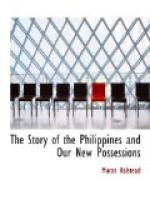Naturally the gallery has many works of art representative of Manila. The shipping in the harbor is an advertisement of a commerce once extensive. Each picture that shows a woman, a man, or tree; a wood-cutter, a fisherman, or a house, opens for the spectator a vista that may be interpreted by the intelligent. A veritable picture is a window that reveals a landscape. That which is most valuable in a gallery like this is the perfect truth not everywhere found, for the eyes that see a picture that is really representative, setting forth the colors, the light, and the substance of things find that which does not fade when the story is told.
There is one most hideous thing in our gallery—that of the head of a Spaniard, bleeding, just severed from the body—the weapon used, a naked dagger in a clenched hand—around the ghastly symbol a deep black border. This is one of the ways of the Katapuna society—the League of Blood—have of saying what they would have us understand are their awful purposes. There are terrible stories about this Blood League—that they bleed themselves in the course of their proceedings, and each member signs his name with his own blood—that they establish brotherhood by mingling their blood and tasting it. They are the sworn enemies of the Spaniards, and particularly of the priests. I inquired of Senor Agoncillo, the Philippine commissioner to Paris, whether those bloody stories were true. He scoffed at the notion that they might be so, and laughed and shouted “No, no!” as if he was having much fun. But Agoncillo is a lawyer and a diplomat, and I had heard so much, of this horrid society I did not feel positive it was certain that its alleged blood rites were fictitious. Of one thing I am sure—that the dreadful picture is no joke, and was not meant for a burlesque, though it might possibly be expected to perform the office of a scarecrow. It cannot be doubted that there are oath-bound secret societies that are regarded by the Spaniards as fanatical, superstitious, murderous and deserving death.
There is a good deal of feeble-minded credulity among the Filipinos, that is exhibited in the stories told by Aguinaldo. He has many followers who believe that he has a mighty magic, a charm, that deflects bullets and is an antidote for poison. Intelligent people believe this imbecility is one of the great elements of his power—that his leadership would be lost if the supernaturalism attached to him should go the way of all phantoms. Aguinaldo is said not to have faith in the charm, for he takes very good care of himself.
We give several views of executions at Manila. As a rule, these pictures are not fine productions of art. They are taken under such conditions of light and background that they are somewhat shadowy. This sinister addition to our gallery seems to be the first time the photographs of executions have been reproduced. The photos were not furtively taken. There is no secrecy about the process, no attempts




